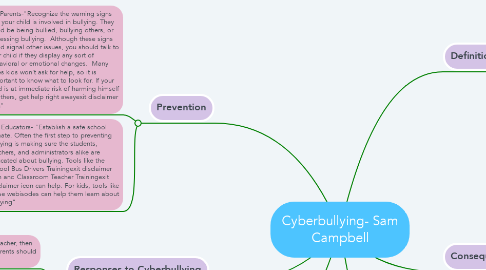Cyberbullying- Sam Campbell
by Samantha Campbell

1. Prevention
1.1. For Parents-"Recognize the warning signs that your child is involved in bullying. They could be being bullied, bullying others, or witnessing bullying. Although these signs could signal other issues, you should talk to your child if they display any sort of behavioral or emotional changes. Many times kids won’t ask for help, so it is important to know what to look for. If your child is at immediate risk of harming himself or others, get help right awayexit disclaimer icon"
1.2. For Educators- "Establish a safe school climate. Often the first step to preventing bullying is making sure the students, teachers, and administrators alike are educated about bullying. Tools like the School Bus Drivers Trainingexit disclaimer icon and Classroom Teacher Trainingexit disclaimer icon can help. For kids, tools like these webisodes can help them learn about bullying"
2. Responses to Cyberbullying
2.1. If the student brings it to the teacher, then bring it to the principal. The parents should also be involved.
2.2. Cyberbullying is not okay under any circumstance. It should be taken very serious by everyone involved.
3. Lesson Ideas
3.1. You could do an assembly as a school on bullying. That could include speakers and a powerpoint/ video.
3.2. If you want the class involved, watch a movie, or put on a play about cyberbullying.
4. Definition
4.1. the electronic posting of mean-spirited messages about a person (such as a student) often done anonymously
4.2. NetSafe Episode 5: Cyberbullies are No Fun! (Grades 4-6)
5. Consequences
5.1. "New Jersey school districts are required to adopt a policy prohibiting harassment, intimidation, bullying or cyber-bullying"
5.2. “Harassment, intimidation or bullying” means any gesture, any written, verbal or physical act, or any electronic communication, whether it be a single incident or a series of incidents, that is reasonably perceived as being motivated either by any actual or perceived characteristic, such as race, color, religion, ancestry, national origin, gender, sexual orientation, gender identity and expression, or a mental, physical or sensory disability, or by any other distinguishing characteristic, that takes place on school property, at any school-sponsored function, on a school bus, or off school, that substantially disrupts or interferes with the orderly operation of the school or the rights of other students
6. Sources
6.1. New Jersey Anti-Bullying Laws & Policies
6.2. What You Can Do


